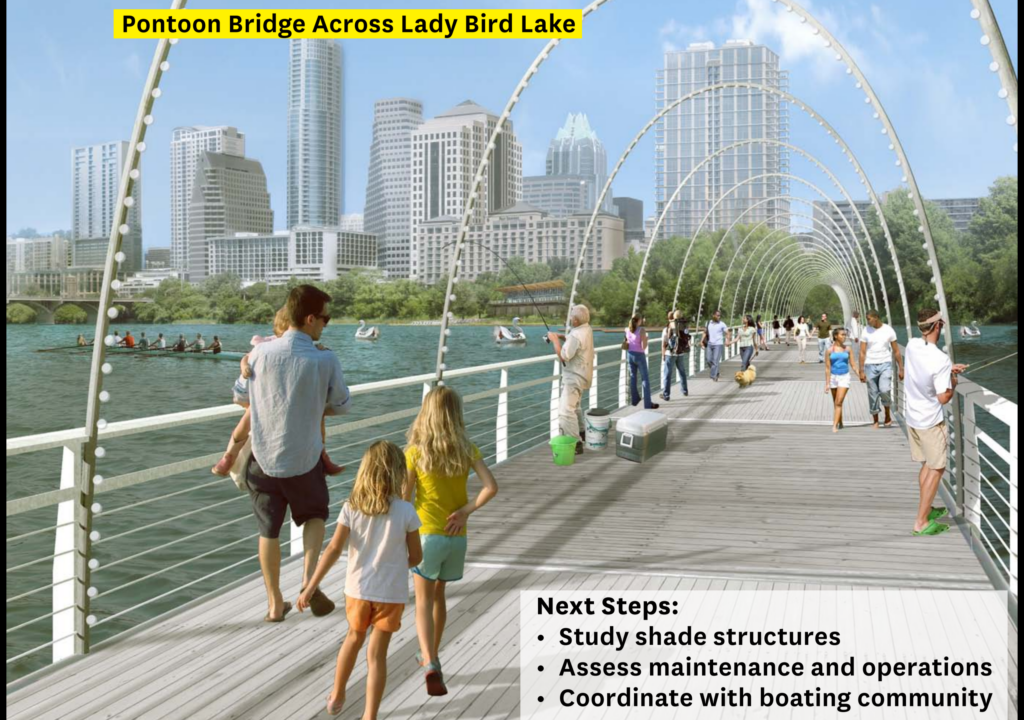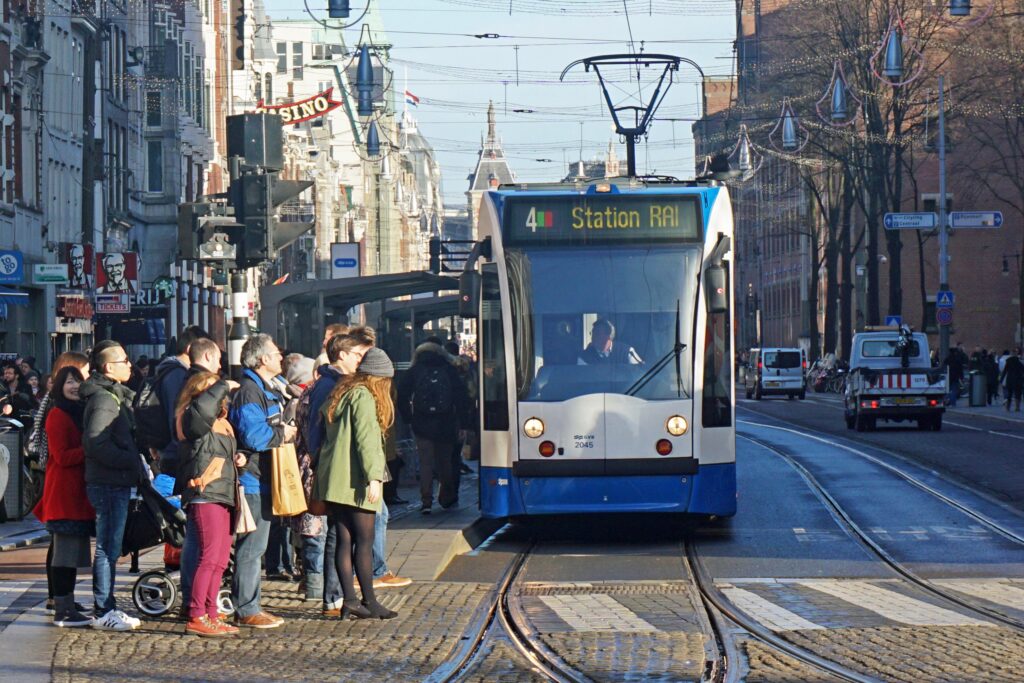Last week I had the privilege of attending an open house for Project Connect, the planning effort to build a high-frequency, high-capacity, fast-running base for Austin’s transit system. Although the in-person open houses for the Orange and Blue lines are over, you can still review the materials and get your feedback heard at the virtual open house. CapMetro didn’t come forward with one fully-baked proposal, but presented a number of choices with tradeoffs: do we go big or go small? Below are my choices and I hope y’all let me know yours!
Route Selection
The basic outlines of the routes have been set. The Orange Line consists of a Northern segment running from Tech Ridge down Lamar and Guadalupe into downtown then down South Congress to Slaughter Lane. The Blue Line starts at ACC Highland, runs through the UT campus to downtown then turns southeast along Riverside to the Airport. However, there are still some choices to make.

How far do we go?
Will we build the whole line in one go? Project Connect imagines all segments except the Airport segment will be truncated at first. The tradeoff is straightforward: more distance costs more to build and more to operate but serves more passengers. As more information comes out about these segments, the tradeoffs will come in sharper focus. Preliminary engineering has uncovered potential flooding issues with the northern segment of the Blue Line running near Waller Creek which may raise the costs of building that segment and portions of the Orange Line are dependent on the cooperation of TxDOT, which isn’t the most transit-positive agency.
My verdict: Go small! This may be the only decision where incremental improvements are possible later. You can’t start by building a concrete busway then rebuild it as rail without tearing up your investment in concrete. But you can start by building shorter lines then extending them later. If we price out the extensions and we can do them now, great! But we don’t want to hold up the rest if there are political, financial, or engineering problems with extension segments.
How the Blue Line crosses the river
There are two options: join up with the orange line and cross together or build an additional bridge from the South Central Waterfront to the Rainey district. Joining up with the orange line saves money by only building one bridge, and also makes the Blue Line flow more naturally from west to east through downtown without having to double back on itself. There are a number of advantages to a second crossing: there’s redundancy in case there’s an issue with one bridge, it’s easier to serve two emerging population centers (Rainey Steet and South Central Waterfront), and you create pedestrian and bicycle connectivity between Rainey Street and the South Central Waterfront.
My verdict: Go big! Austin will eventually have to build more bridges to provide more connectivity. It’s more efficient to do that in coordination with building the transitway so we don’t have wasted investment in misplaced transitways and stations.

Grade Separation
“Grade separation” is a fancy way of saying that the buses or trains don’t run right along the streets but rather above or below it. There’s one huge advantage to grade separation: transit can run faster and safer when it doesn’t need to worry about intersections with drivers or cyclists or pedestrians, etc. The disadvantages are that it can be very expensive, sometimes ugly or loud, and less connected to the street.
Downtown Tunnel
The most expensive grade separation contemplated is a downtown tunnel. CapMetro presented a few options, including no tunnel, a lot of tunnel and a little less tunnel. The advantages and disadvantages are as described above.
My verdict: Go medium! Orange line tunnel seems very worth it, because otherwise surface buses running north-south throughout the city will be disturbed by the high-capacity transitway. Blue line tunnel along fourth also seems worth it. We’re going to want these tunnels eventually and it won’t get any cheaper in time. Blue line tunnel along the east side of downtown strike me as less vital.
Elevated Transitway
For both the Orange and Blue line, CapMetro presented two scenarios: 10% elevated / 90% surface and 50 / 50. This is because parts of the route obviously need elevated and parts obviously don’t. What’s left is a 10% to 50% spectrum of segments that could go either way.

My verdict: Go medium! Some folks love the vision of surface-running rail like the beautiful European streetcar systems. Some love elevated tracks, similar to some of the most efficient transit cities in the US. As more engineering is done on individual segments, the costs and benefits for individual segments will become more clear and we’ll probably land around 30% elevated.
Bus Rapid Transit vs Light Rail Transit
Admit it: you skipped the other sections to see what I’d say about vehicles. No shame! Buses are cheaper than trains: concrete transit lanes are cheaper than train tracks. Even fancy, extra-long electric buses are still cheaper than train cars. Bus depots are cheaper than railyards and signals and track maintenance for trains essentially have no analog in buses. The cost subject has been a touchy subject in Austin’s transit conversation so I’ll likely do a whole blog post on this later.
For the extra money, trains buy you more. The biggest area is capacity. A single train car holds more people than an extra-long bus and you can tie cars together. BRT is capable of carrying higher capacity loads than Austin anticipates, but the systems around the world that do this have essentially dedicated four-lane highways to nothing but buses and use extra-long buses with three sections that have difficulty taking turns. This takes away some of the flexibility of running buses! Even some of the most successful BRT cities have eventually had to spend again to add rail. As Austin grows, we may find ourselves with a BRT system crowded and choking on high loads with no simple option to expand it.
The other big advantage of trains is more political. Trains ride smoother and attract more passengers than buses. Indeed, Project Connect’s ridership estimates show that going from bus to train adds as many riders as speeding up the system by going from surface to elevated. I’m not convinced BRT buses would feel much worse than trains. Electric buses are less loud, jerky, and polluting than diesel buses. But I’m entirely convinced the rest of the city is unconvinced. As I’ve talked to both more and less engaged people around the city, I’ve often gotten a look of exasperation at the concept of BRT: “We’re going to spend billions on a bus?” If I saw polling that said the electorate would be excited to spend billions on BRT during a scorched-earth, anti-transit campaign led by the Don Zimmermans of the world, this advantage might be smaller. But I doubt that’s going to happen — especially because of Austin’s experience with MetroRapid buses being misbranded as “BRT.”
My verdict: Go big! Both for short-term reasons (winning the election) and long-term capacity.
Get Hyped
I’m excited, y’all.

This blog started with a series of exasperated posts about the 2014 rail / highway bond and my view as a data-fluent transit layperson who found a lot of the ideas communicated unbelievable. The world is very different now. The land development code rewrite could go further, but it’s looking to be a net positive for adding transit-ready population. City Council members are committed to planning land use and transit together through ideas like lowering or eliminating parking requirements near transit. I’ve found the Project Connect planning team to be extremely professional and when I raise issues, it’s obvious they’ve already wrestled with them. The plan proposed is not a single line but a true system vision prepared by people who know what they’re doing — and matching the intuitions of people who live here.
CapMetro itself is in much better shape now than it was then. The agency has embarked on a number of small, incremental fixes over the last couple of years: it’s opened a new operations command center, built a ton more bus shelters, improved the real-time bus-tracking system, made improvements in its app, offered free rides for kids with the money offset by advertising revenues, and worked with the city to get around traffic chokepoints like the intersection of Lavaca and MLK. The results have been noticeable in ridership numbers. We have 16 months since CapRemap shook up Austin’s bus system and boosted ridership. In the four months we have year-over-year data post-Remap, ridership on local bus routes has continued to grow a health 7.5%. And after the years-long delay in opening the Red Line, CapMetro’s recent early, on-budget completion of its downtown station expansion is a good sign for improved construction management.
As great as it is to have our transit agency making nice, incremental ridership gains through small improvements, there’s a limit to how good buses running in heavy traffic can ever get. To change the city from being a drive-first city with a transit option to a city where transit is a bona fide first-choice for many people, we need to make a major investment. With traffic threatening our city’s future and climate change staring down our species’ future, I’m excited that we have the real chance to see a big improvement in transit in Austin!

